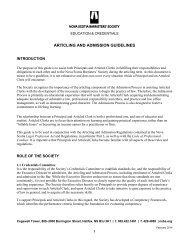SR Vol 27 No 3, July 2009 - Nova Scotia Barristers' Society
SR Vol 27 No 3, July 2009 - Nova Scotia Barristers' Society
SR Vol 27 No 3, July 2009 - Nova Scotia Barristers' Society
You also want an ePaper? Increase the reach of your titles
YUMPU automatically turns print PDFs into web optimized ePapers that Google loves.
to subject youth to an adult sentence and would make protection<br />
of the public one of the primary goals of the legislation - all would<br />
contribute further to an erosion of the fundamental principles of<br />
juvenile justice. The former Conservative provincial government<br />
embraced these six recommendations and began a political campaign<br />
to garner public support to petition for federal revisions.<br />
While the provincial Minister of Justice claimed to have support<br />
from thousands of <strong>No</strong>va <strong>Scotia</strong>ns along with mayors and town<br />
councils representing 60 per cent of <strong>No</strong>va <strong>Scotia</strong>ns, neither research<br />
evidence nor the lessons of history would support any of these<br />
proposed revisions as sound policy or good law. Rather, the proposed<br />
revisions represent political opportunism and an example of a bad<br />
case leading to bad law. Over the last 25 years, persistent media<br />
coverage of exceptional youth crime cases has resulted in a general<br />
public fear of youth and, like their counterparts in the United States,<br />
some Canadian politicians have attempted to garner public favour<br />
by pandering to these fears and promising to “crack down” on crime,<br />
particularly youth crime.<br />
For the most part, the YCJA is a good piece of legislation to the<br />
extent that it attempts to address a number of problems created by<br />
the range of contradictory principles of the YOA. Guiding principles<br />
have been simplified in the YCJA and more specific principles are<br />
established for application at particular decision making points.<br />
<strong>No</strong>tably, deterrence is not one of these principles nor has it ever been<br />
a legislated sentencing principle in the history of the juvenile justice<br />
system in Canada. Under the YOA, appeal court judges disagreed<br />
about the relevance of general or specific deterrence as a principle of<br />
sentencing in youth cases [R. v. G.K. (1985), 21 C.C.C. (3D) 558<br />
(Alta. C.A.); R. v. O. (1986), <strong>27</strong> C.C.C. (3D) 376 (Ont. C.A.)] and<br />
now with the YCJA there is more agreement among judges that it is<br />
not a relevant sentencing principle (Bala and Anand, 2004, p. 260).<br />
The current proposal to include deterrence as a principle in<br />
sentencing is another way of eroding the system. The John Howard<br />
<strong>Society</strong> has addressed this issue and recommends that deterrence and<br />
denunciation should not be included as sentencing principles in the<br />
YCJA for three reasons. First, there is simply no evidence that “...<br />
deterrence or punitiveness reduce crime or reoffending.”(2008:12)<br />
and more evidence that it has a negative impact on sentence. According<br />
to Madame Justice Charon, when general deterrence is applied as a<br />
factor in sentencing it “... has a unilateral effect on the sentence....<br />
it will always serve to increase the penalty or make it harsher.” R. v.<br />
B.W.P.; R. v. B.V.N., [2006] 1 S.C.R. 941, 2006 SCC <strong>27</strong> as cited in<br />
Knudsen and Jones, 2008: 13). Furthermore, general deterrence as<br />
a principle of sentencing is a contravention of principles of juvenile<br />
justice as laid out by the UN Convention on the Rights of the Child<br />
and the United Nations Rules for the Protection of Juveniles Deprived<br />
of their Liberty. The imposition of harsher sentences for the purpose<br />
of deterring future crime contravenes principles of proportionality,<br />
the child’s best interest and minimal interference with freedoms. This<br />
not only constitutes another erosion of the fundamental principle of<br />
juvenile justice, it also does not make for “good law.”<br />
Similarly, the proposed changes to pretrial detention will not make<br />
for good law and will also further erode the juvenile/youth justice<br />
system. One of the reasons for custody and detention provisions in<br />
the YCJA was the overuse of custody and detention under the YOA.<br />
Furthermore, while the YCJA does seem to have had a reducing effect<br />
on custody sentences, we have not yet seen a reduction in either high<br />
rates of detention, jurisdictional variations in the use of detention or<br />
the overuse of detention for marginalized and minority youth. The<br />
proposed changes are more likely to increase the use of detention and<br />
then, because those held in pretrial detention are more likely to receive<br />
custody sentences, rates of custody sentences will likely increase in the<br />
long run. It is also not clear why strengthening detention provisions<br />
were even a concern for the Nunn Commission. In the youth case<br />
that precipitated the inquiry, a <strong>No</strong>va <strong>Scotia</strong> court had found that there<br />
were sufficient grounds to hold the youth in question in detention but<br />
the court nonetheless made a responsible person order (Department<br />
of Justice Consultation Paper, 2008:31). In December 2008, the<br />
federal Department of Justice put out a discussion paper based on a<br />
thorough review of the evidence regarding pre-trial detention. Based<br />
on this evidence, pretrial detention issues, for the most part, have<br />
more to do with reducing discretionary decision-making, clarifying<br />
aspects of s. 29 and s. 39 of the YCJA and addressing the effectiveness<br />
of conditions of release.<br />
These are issues aimed at making better law because these issues<br />
have the potential for progressive change, ones that can be expected<br />
to address regional and jurisdictional variation and disparity. This<br />
approach to reform looks for inconsistencies, problems and weaknesses<br />
in the legislation and its administration, rather than looking for<br />
ways to change the fundamental purpose of the system in the hopes<br />
that something about the law will stop youth crime. Youth crime<br />
issues are better addressed in the context of broader youth issues and<br />
government funding.<br />
Over the last 25 years, most cases involving violent youth crime<br />
have led to claims that the legislation is ineffective. It is believed that<br />
somehow, if the legislation was not so “lenient” the crime would not<br />
have occurred. Interestingly, while in Scotland recently researching<br />
their law reform process in the 1960s that led to the abandonment of<br />
a criminal justice framework for responding to youth crime in favour<br />
of a social welfare approach, a particularly violent and horrific crime<br />
occurred involving the rape and violent murder of a young woman by<br />
a 15-year-old boy. Scottish newspapers were full of stories for at least<br />
a week about the crime, the offender, the victim and public reaction.<br />
Based on my experience in Canada, I expected to hear outcries<br />
through the news media for changes to their legislation. Much to<br />
my surprise, not one voice was raised in criticism of the legislation or<br />
system. Rather, the public issues in the news media revolved around<br />
discussions about “What went wrong?” “Who dropped the ball?”<br />
“How did this youth fall through the cracks?” In other words, the<br />
Scottish public seemed to have faith in their 40-year-old system and<br />
method of responding to youth crime.<br />
One of the goals of our justice system is to maintain public confidence<br />
in the youth justice system and its administration, yet it seems<br />
painfully apparent that more tinkering with a system that has been<br />
under attack and modified repeatedly over the last 40 years is not<br />
about to change public attitudes or for that matter, the incidence of<br />
youth crime. Revisions should be entertained that will solve issues<br />
with the administration of youth justice and the system’s failure to<br />
provide for the needs of many youth in the system. Revisions should<br />
also honour the fundamental precepts of a juvenile justice system and<br />
international standards rather than reflect ill-advised political agenda<br />
and rhetoric.<br />
<strong>July</strong> <strong>2009</strong> 35
















